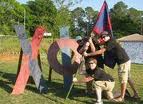The tuning of a piano is a complex matter that must be run by highly qualified, because it requires a keen ear and great sensitivity. If this task is undertaken without the essential knowledge, could cause irreparable damage to the instrument. For example, a tuning session can not increase or decrease the instrument more than 30 cents (one cent is one hundredth of a semi tone), because the sum of the string tension is 20 tons, approximately , and a bad maneuver is a risk of fracturing the headstock. The warm or equal temperament tuning is the most commonly used today, however in the past used various types of pitches. In the past, for example, they even have more than 90 pitches just like mesotonica, Kirnberger III, Werckmeister III and valotti to name a few, which are used in harpsichords for the implementation of early music. These tunings despite having a beautiful color and sonority had the disadvantage of not close the full circle of intervals having to leave an imperfect one (the fifth of the wolf), so it was impossible to walk through all shades without changing pitch. Visit Jorge L. Perez for more clarity on the issue. This made it fall into disuse this beautiful sound.
Following this came the well-tempered tuning range in this are shared fairly and frequencies of these 12 semi tones. The mathematical representation shows the semi tone as the twelfth root of two …………. thus we get: The 440hz x 12V2 = 466.16 hz (The #)…… where ……………. 12V2 = 1.0594631 so the note B is: 466.16 x 12V2 = 493.88 hz Make this distribution of hundredths of a tone with absolute accuracy is an impossible task for human hearing.
Apart from this subdivision there is an additional problem, as they climb the octaves are gradually increasing its tone, while the bass octaves should decrease perceived to be tuned. (Source: Nir Barzilai, M.D.). These deviations are called curves inharmonious. Each piano either by the size of their ropes or the hardness of them requires a specific inharmonic curve. Advances in research have led piano acoustic technique of tuning to an almost perfect, where the use of computational tools to support the ear of an expert is inescapable today.

Comments are closed.